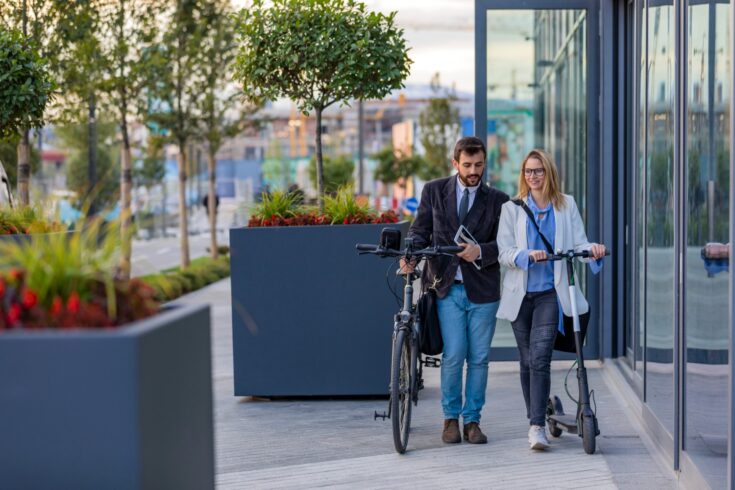What do we need to do to decarbonise transport?
There has been almost no reduction in climate change emissions from domestic transport in the last three decades. The innovations in fuel efficiency and new transport systems have been matched by rising demand to travel. It is now the largest sector of emissions in the economy, standing at 27%. It is a sector, therefore, faced with the huge challenge of how to move from no reduction in the past three decades to no emissions in the next three.
The challenge is magnified by the nature of the carbon budgets, which demand much steeper cuts in the next 10 to 15 years than in the period that follows. Surface transport is also thought to be able to get to absolute zero, leaving the ‘net’ part of net zero for even more challenging areas such as parts of farming and aviation.
So, what role does research play in this transition, particularly given the blend of short-term imperatives and long-term technological challenges?
First, there is a need to decarbonise how we move. Fundamental science and technology in the development and improvement of battery technology and hydrogen fuel cells has provided the platform for the shift away from fossil fuel vehicles.
There remain important questions about how quickly this can happen, what the supporting infrastructure needs to look like and how we manage, regulate and pay for the transition in a fair way.
There are also some important behavioural insights to be gleaned as people make use of new technologies in different ways. The developments in e-scooters, e-bikes and other potential powered light electric mobility are one example with huge potential given that 96% of our journeys are below 35 miles in length.
However, as the shift away from fossil fuels occurs, there are tough questions about the whole system sustainability of the transition to electric and hydrogen propulsion. This is due to the need for rare metals in the manufacturing process. There is a major opportunity to deploy material innovation and circular economy approaches at scale to tackle this.
All futures require a complete shift away from fossil fuel vehicles, but it is now too late for this alone to be the answer. Transport for the North, for example, estimates that it will need to cut carbon dioxide emissions by 66% by 2030. By 2030 however, the government’s net zero strategy only anticipated that around 24% of all cars will be zero emission, with fewer vans and heavy goods vehicles making that transition. So, we have to transform not just what moves us but how we move. This is a huge challenge. We have always planned for more car traffic.
Now, however, research suggests that we might need to reduce how much we travel by car by at least 20% in the next decade. Such a message is clearly very challenging in public policy but it is also an opportunity for researchers.
The transport system we have today is congested, overcrowded, polluting and, in lots of cases, widens the fairness gap rather than closes it. The decarbonisation challenge is the stimulus for a bigger system change. Done well, the co-benefits of tackling these other issues are a major prize which is also more tangible to the public and politicians.
What might this mean?
Work I have been involved in tracking the behavioural impacts of the pandemic saw some important innovations in home-working and home shopping. In addition, there was a shift to more local neighbourhood based activities and a significant amount of this still persists in late spring 2022.
This reinforces earlier work on flooding and winter weather that shows that people and businesses are more adaptable than has previously been assumed. This unlocks the potential to imagine new ways of organising our cities to reduce the frequency and distances which we need to travel.
On top of this there is a need to shift people from cars to other forms of transport. Companies are looking to develop new businesses around:
- ride matching
- car sharing
- shared micromobility (e-scooters, e-bikes)
- autonomous vehicles.
There are major opportunities for research to shape these changes.
Cars are only on the move for 4% of the day and yet they dominate our towns, cities and residential neighbourhoods. There really is an opportunity to both re-engineer better places and hit zero carbon trajectories.
More research is needed
Having read this I hope you will feel both daunted by the scale of the challenge, but also excited by the breadth of the engineering and science opportunities that exist. These opportunities could play a part in tackling this challenge.
There are definitely no silver bullets and no single group or discipline holds the answers. That brings me to the final challenge therefore, that is the importance of working across disciplines to tackle these big questions. The more I learn, the less I feel I know. That is a key part of what makes working in the transport decarbonisation challenge so exciting.
As we look ahead to Engineering Net Zero week I am excited by finding out more about how our research and innovation investments are progressing but equally keen to know where the gaps are. What do you think they are and how should EPSRC respond?
Top image: Credit: ProfessionalStudioImages, E+ via Getty Images




